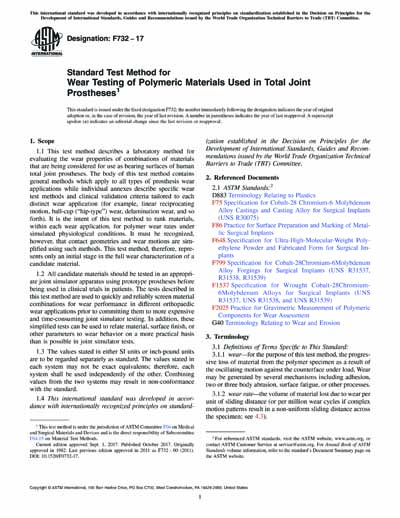Most recent
ASTM F732-17
Standard Test Method for Wear Testing of Polymeric Materials Used in Total Joint Prostheses
1.1 This test method describes a laboratory method for evaluating the wear properties of combinations of materials that are being considered for use as bearing surfaces of human total joint prostheses. The body of this test method contains general methods which apply to all types of prosthesis wear applications while individual annexes describe specific wear test methods and clinical validation criteria tailored to each distinct wear application (for example, linear reciprocating motion, ball-cup (“hip-type”) wear, delamination wear, and so forth). It is the intent of this test method to rank materials, within each wear application, for polymer wear rates under simulated physiological conditions. It must be recognized, however, that contact geometries and wear motions are simplified using such methods. This test method, therefore, represents only an initial stage in the full wear characterization of a candidate material.
1.2 All candidate materials should be tested in an appropriate joint simulator apparatus using prototype prostheses before being used in clinical trials in patients. The tests described in this test method are used to quickly and reliably screen material combinations for wear performance in different orthopaedic wear applications prior to committing them to more expensive and time-consuming joint simulator testing. In addition, these simplified tests can be used to relate material, surface finish, or other parameters to wear behavior on a more practical basis than is possible in joint simulator tests.
1.3 The values stated in either SI units or inch-pound units are to be regarded separately as standard. The values stated in each system may not be exact equivalents; therefore, each system shall be used independently of the other. Combining values from the two systems may result in non-conformance with the standard.
1.4 This international standard was developed in accordance with internationally recognized principles on standardization established in the Decision on Principles for the Development of International Standards, Guides and Recommendations issued by the World Trade Organization Technical Barriers to Trade (TBT) Committee.
Content Provider
ASTM International [astm]






